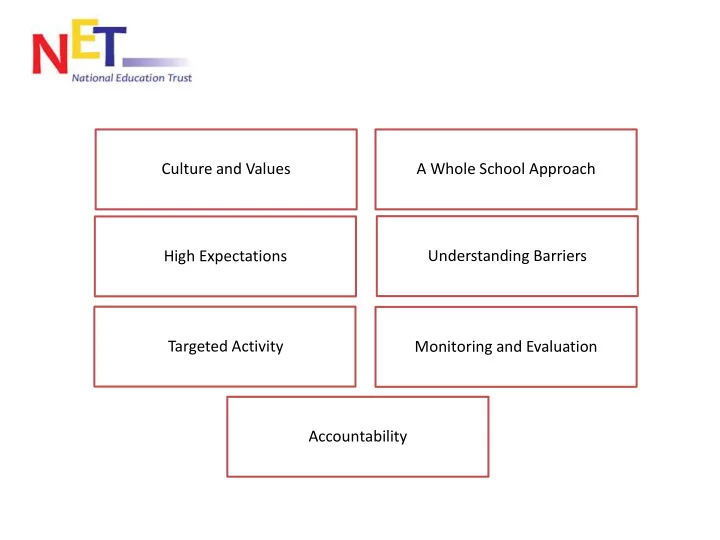

Culture and Values A Whole School Approach High Expectations Understanding Barriers Targeted Activity Monitoring and Evaluation Accountability
Leadership Where is your money spent? PP Spend PP Spend £12,000 £12,000 £10,000 £10,000 £8,000 £8,000 £6,000 £6,000 Spend Spend £4,000 £4,000 £2,000 £2,000 £0 £0 R 1 2 3 4 5 6 R 1 2 3 4 5 6 Year group Year group 3
High Expectations You don’t win races by wishing… you have to train hard and strive your upmost, and sometimes even that isn’t enough. If you want something, you can have it, but only if you have what goes with it… all the hard work, all the despair, and only if your willing to risk failure. That’s the problem with Karl. He was afraid of failing, so he never really tried. 4
5
6
7
8
9
Mistaking Improvement: How to make it look as if your improvement project has worked (Coe) 1. Wait for a bad year or choose underperforming schools to start with. Most things self-correct or revert to expectations (you can claim the credit for this). 2. Take on any initiative, and ask everyone who put effort into it whether they feel it worked. No- one wants to feel their effort was wasted. 3. Define ‘improvement’ in terms of perceptions and ratings of teachers. DO NOT conduct any proper assessments – they may disappoint. 4. Only study schools or teachers that recognise a problem and are prepared to take on an initiative. They’ll probably improve whatever you do. 5. Conduct some kind of evaluation, but don’t let the design be too good – poor quality evaluations are much more likely to show positive results. 6. If any improvement occurs in any aspect of performance, focus attention on that rather than on any areas or schools that have not improved or got worse (don’t mention them!). 7. Put some effort into marketing and presentation of the school. Once you start to recruit better students, things will improve.
• Success criteria: Be specific! Activity (e.g.) Treat with caution… Better! Additional teacher ‘Improved’ end of key Group of children using responding to verbal time to provide stage outcomes / feedback in x subject as evidenced in books specific verbal ‘Improved’ progress feedback on areas for improvement Sports activity at the Children ‘enjoyed’ the Sustained reduction in the number of start of the day session behavioural incidents over a given period. to improve behaviour Homework club to Number of pupils Number of disadvantaged pupils signing up improve quality and signing up and attending over a period of time. Feedback quantity of from teachers that quality and quantity of homework homework from pupils has improved. Series of school trips Improved engagement Measurable and sustained improvements in linked to the in lessons ‘observed’ the quality of pupil’s writing evidenced in curriculum as part of books. enrichment 11
Pupil Premium Statements * A simple statement about the purpose of the Pupil Premium * A report evaluating the success of the previous year’s spending * Statement about the rationale for the current year’s spend (e.g. in- school analysis, evidence, guidance, external review) * Clearly defined activity, who it is focussed on and the expected impact. * Dates for quality monitoring, impact evaluation. * ‘Last reviewed’ date. * A contact for enquiries * Guidance about how to claim FSM for parents 12
For Self / Peer Review Analyse the expenditure and impact of your current pupil premium funding, including Higher, Quiet Middle… Have progress and attainment data for pupil premium and others in each year group (including any data showing ‘gaps within gaps’). Analyse the amount of funding being spend in each year group. Analyse the major barriers to learning disadvantaged learners at the school. An analysis of the attendance of disadvantaged learners. If you are ability grouping, analyse the sets in which disadvantaged pupils are represented. Write a strong, confident Pupil Premium Statement – look at Stocksbridge Junior School as an example. Regularly update a short Self Evaluation of strengths and weaknesses… An analysis of whether marking is suitably tailored to their needs and barriers. What is the impact of marking, how are we ensuring it is high quality. An analysis of whether disadvantaged pupils are taking part in wider school life 13
Recommend
More recommend